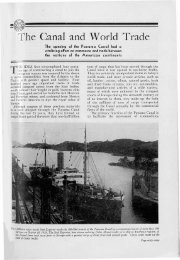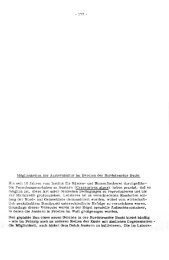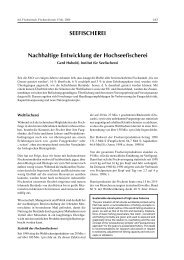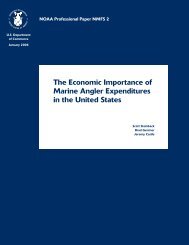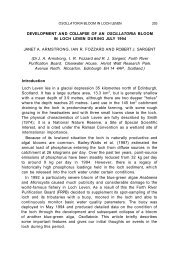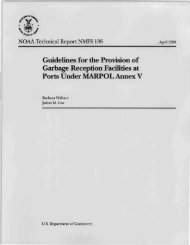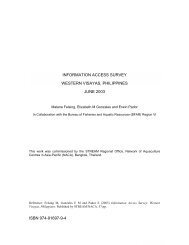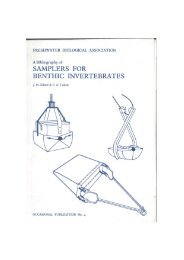Download - Aquatic Commons
Download - Aquatic Commons
Download - Aquatic Commons
You also want an ePaper? Increase the reach of your titles
YUMPU automatically turns print PDFs into web optimized ePapers that Google loves.
Methods<br />
Checklist of Shallow-Water Echinodermata of Florida<br />
Names on the initial draft of this list were extracted<br />
from Echinoderms of Florida and the Caribbean (Hendler<br />
et al., 1995) and then supplemented or confirmed by information<br />
from many other published sources, which<br />
are listed in the accompanying compendium of pertinent<br />
references. Some of the more comprehensive references<br />
consulted during preparation of the list are the<br />
following, listed in alphabetical order: A. M. Clark and<br />
Downey (1992), Downey (1973), Durham et al. (1966),<br />
Frizzell et al. (1966), Harold and Telford (1990), Hendler<br />
(1995), Hopkins (1988), Kier and Grant (1965), Messing<br />
(1978), Miller and Pawson (1984), Ruppert and Fox<br />
(1988), Serafy (1979), Spencer and Wright (1966),Thomas<br />
(1962), Thomas (1973), and Tortonese and Downey<br />
(1977). Many additional papers on the systematics of<br />
Florida taxa were consulted, most of which dealt with<br />
only one or a few species; included in this group are<br />
several papers each by R. H. Chesher, A. H. Clark, E.<br />
Deichmann, D. M. Devaney, M. E. Downey, G. Hendler,<br />
P. M. Kier, J. E. Miller, D. L. Pawson, D. K. Serafy, R. L.<br />
Singletary, L. P. Thomas, and R. L. Turner, as well as a<br />
few others included in the list of pertinent references.<br />
In several instances, the database of the Florida Marine<br />
Research Institute Marine Specimen Collection<br />
was searched for depth records to indicate whether a<br />
species should be listed.The draft list of names was then<br />
sent to three reviewers (see Acknowledgments), one of<br />
whom suggested several additions to and deletions<br />
from the list and all of whom helped by filling in missing<br />
information on the authorities (authors’ names<br />
and dates of introduction) for some of the higher taxa.<br />
This list of shallow-water taxa includes all echinoderms<br />
known to occur in Florida’s estuaries and<br />
coastal waters offshore to depths of about 37 m (120 feet;<br />
20 fathoms). A few of the listed species are principally<br />
deeper-water organisms whose ranges extend only<br />
slightly into shallow coastal waters. The ranges of<br />
species in this group, which includes the echinoids<br />
William G. Lyons<br />
Genocidaris maculata and Stylocidaris affinis, the ophiuroid<br />
Astroporpa annulata, and perhaps a few others,<br />
begin at about 30-35 m and extend offshore to much<br />
greater depths on the continental shelf.Those species<br />
are included here for completeness, but it is unlikely<br />
that most of them will be found in shallower depths.<br />
The ophiuroid Amphioplus abditus is known to occur<br />
from Maine southward to Sapelo Island, Georgia, typically<br />
in shallow water but also out to depths of 40 m<br />
(Hendler, 1995). The species is listed here on the suspicion<br />
that any species found at Sapelo Island, Georgia,<br />
may eventually be found in coastal waters of extreme<br />
northeastern Florida.<br />
The classification of taxa follows that used in the<br />
most recently published revisions, but with one exception.<br />
The ophiuroid Amphipholis atra (Stimpson,<br />
1865) has customarily been classified in the genus Amphiodia<br />
Verrill, 1899 (e.g., Hendler et al., 1995) but is<br />
listed here in Amphipholis Ljungman, 1867, following<br />
the advice of Dr. R. L.Turner.<br />
Acknowledgments<br />
Draft lists of echinoderms were reviewed by Dr. David<br />
L. Pawson, Department of Invertebrates, U.S. National<br />
Museum of Natural History, Smithsonian Institution,<br />
Washington, D.C.; Mr. Roger Portell, Department of Invertebrate<br />
Paleontology, Florida Museum of Natural<br />
History, Gainesville; and Dr. Richard L. Turner, Department<br />
of Biological Sciences, Florida Institute of<br />
Technology, Melbourne. Each of the reviewers contributed<br />
comments that improved the list. I am especially<br />
grateful to each of them for providing hard-tofind<br />
information on authorities for some of the higher<br />
taxa; that information proved to be quite troublesome<br />
to locate for some groups. Sandra LaGant, Florida Department<br />
of Environmental Protection, Florida Marine<br />
Research Institute, also assisted by providing<br />
depth records for several taxa from the database of the<br />
Institute’s Marine Specimen Collection.<br />
FMRI Technical Report TR-3 191



